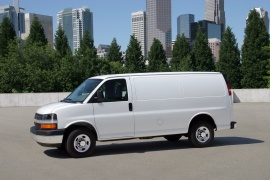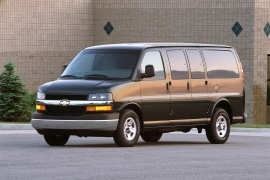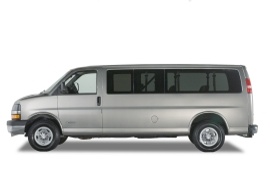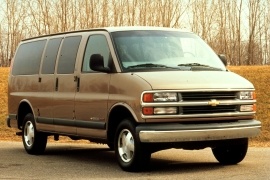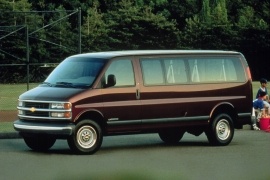CHEVROLET Express Models/Series Timeline, Specifications & Photos
First production year: 1995
Engines: Gasoline, Diesel, Hybrid
Body style: Van
Chevrolet introduced the Express lineup in 1996 and created one of the best choices for the LCV market, and the passenger version offered room for fifteen people inside.
The Express was like a Swiss-army knife. It could be a delivery van, a limousine, a school bus, or an office on wheels. GM made it available in three different GVWR levels labeled as 1500, 2500, or heavy-duty 3500. Chevrolet built it with two wheelbases so that it could fit everyone's needs.
General Motors had over a century of experience in building utility vehicles, and that was noticeable. It was also a leading main supplier for car rental companies, and that included the U-Haul. The Express was specifically built for commercial use and designed in a form-follow-function idea. Its flat side panels made a great advertisement area for businesses. At the front, the carmaker installed a horizontal slat on the grille, sporting the bow-tie badge in the middle. Depending on the trim level and options, it offered wide headlights or smaller ones, both rectangular.
In 2003, the carmaker added a refreshed version and in 2008 introduced more safety features. It included curtain airbags and GM's StabiliTrak (ESP) as standard. In addition, the carmaker added a new audio system on the industrial-looking dashboard to improve comfort, which included a 6-CD in-dash unit and Bluetooth connectivity.
Under the hood, depending on the GVWR, it provided a range of four gasoline engines. Chevrolet exclusively offered the 6.6-liter turbo-diesel on the 3500 version.
A modern design for 2002 and a body-on-frame construction, the Chevrolet Express was a full-size van.
For 2002, the Express got slight updates such as rear-view mirrors with integrated compass and temperature reading, lower CO2 emissions and an upgraded starter.
Seating configurations were available for 5, 8 and 12 passengers, while an extended version was also available, offering seating for up to 15 passengers.
Buyers could choose from a variety of engines available. The most powerful unit offered was the 8.1-liter V8, an engine that cranked out 340 hp and 455 pound-feet of torque. Other available powerplants were a 4.3-liters V6, a 5.0-liter and 5.7-liter V8 and a 6.5-liter turbodiesel V8.
Luxury was also available with the upscale LT trim level, the Express featuring leather upholstery, an optional premium audio system and dual-flip monitors.
Standard features with the base and the LS included child safety locks, front air-conditioning, vinyl seats, antilock brakes and daytime running lights.
The LS trim level added different cloth upholstery, power windows and power locks and cruise control.
Chevrolet kept improving the Express within the years, and for 2004, the van featured the Stabilitrak system (stability control) as standard. In 2008, the interior was completely restyled to bring it more up to date.
The model was available with a 3-door or a 4-door body style, to better suit the needs of the future buyer.
Chevrolet refreshed its Express Van lineup in 2002, and it went a little further than just adding new blinkers and colors.
This body-on-frame minivan was the king of charter vans, and they could've been seen in most, if not all, airports around the country. Moreover, they were also converted into mobile homes and mobile offices.
In the long-wheelbase version, this vehicle was used for country trips, and the carmaker decided to give it a new, polished image. Thus, the front fascia received a redesigned chromed horizontal slat that sported the bow-tie badge. Since it crossed all the vehicle's width, it separated the headlights from the lower-mounted blinkers and parking lights. Depending on the trim level, the bumper featured a chromed lower area, which coped better with stone chips than regular paint. There were new 60/40 access doors on the driver's side as an option.
Inside, apart from the compass integrated into the rearview mirror, the carmaker added new upholstery and colors. Yet, the plastics were still at the same poor, utility-van level. Depending on the options, the Express Van LWB was available with up to 15 seats.
But the most important upgrade for the 2003 model year was the drivetrain, which received an AWD version as an option. Moreover, there were newer, fuel-efficient engines. They were all paired with a four-speed automatic transmission. GM offered the Express Van LWB with a choice of gasoline, turbo-diesel, and flex-fuel engines.
Chevrolet introduced the Express lineup in 1995 as a replacement for the older G-Series vans and started a new chapter for its LCV department.
The bow-tie brand had a long history in producing utility vehicles, and it used it to develop a new one from the ground up. It used the body-on-frame construction and the same chassis as some of its pickups or heavy-duty trucks.
It wasn't easy to make a box-on-wheels look like ca reasonably designed vehicle, but Chevrolet tried it hard. After all, even if it was the church's bus or the contractor's workhorse, it didn't have to look bad. Its front fascia showed a dual headlights system like the one installed on the Silverado pickup and a wrapped-around front bumper. Chevrolet offered the Express in two sizes with two wheelbases.
Inside, the customer could choose from a wide variety of interiors. The Express was available as a panel van to be reconfigured by a specialized coachbuilder, as a bus with seats on the sides, or as a family MPV with two or three rows of seats. The only part that came with all the versions was the dashboard, which was tall and offered a car-like experience thanks to its rounded design and the gear-selector mounted on the steering column.
Chevrolet offered a very wide choice of engines: from an affordable 4.3-liter V-6 to a huge 8.1-liter V-8.
Chevrolet introduced a long-wheelbase version for the 1995 Express for both body versions: light-utility van and people-carrier.
With its long history in producing utility vehicles, the bow-tie brand tried to stay ahead of its competitors and updated the three-decades-old Chevrolet Van/Beauville. Even though it followed the same basics for a body-on-frame construction, the evolution went far beyond the vehicle's look.
It wasn't easy to make a box-on-wheels look like ca reasonably designed vehicle, but Chevrolet tried it hard. After all, even if it was the church's bus or the contractor's workhorse, it didn't have to look bad. Its front fascia showed a dual headlights system like the one installed on the Silverado pickup and a wrapped-around front bumper. Chevrolet offered the LWB version with either a long sliding door or a twin-door system (refrigerator doors) on the passenger's side.
Inside, the customer could choose from a wide variety of interiors. The Express was available as a panel van to be reconfigured by a specialized coachbuilder, as a bus with seats on the sides, or as a family MPV with two or three rows of seats. The only part that came with all the versions was the dashboard, which was tall and offered a car-like experience thanks to its rounded design and the gear-selector mounted on the steering column. For the 1500 and 2500 series, Chevrolet installed standard dual airbags.
Chevrolet offered a choice of four engines ranging from an affordable 4.3-liter V-6 to a big-block 8.1-liter V-8.
